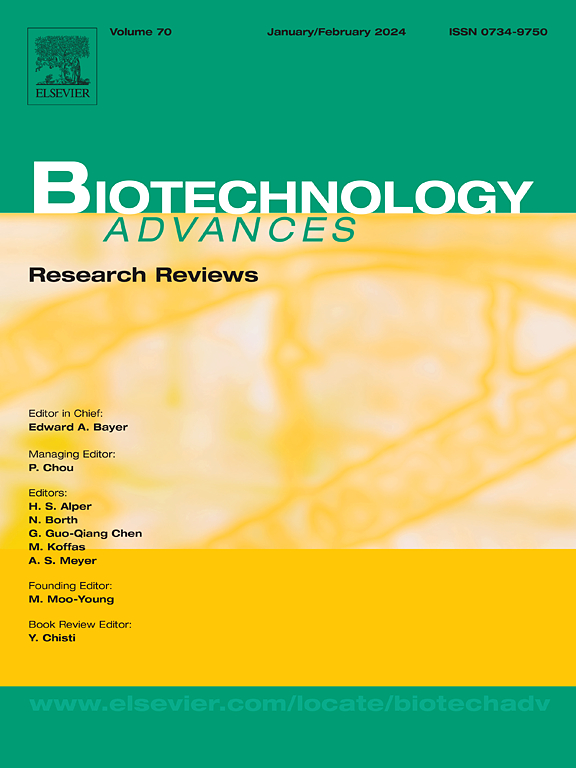赋能农杆菌:三元载体系统作为植物转化和基因组编辑的新武器
IF 12.5
1区 工程技术
Q1 BIOTECHNOLOGY & APPLIED MICROBIOLOGY
引用次数: 0
摘要
植物转化技术的不断发展是加速农业遗传进步的关键。其中,三元载体系统已经成为一种变革性的创新,通过克服关键的生物屏障,显著增强了农杆菌介导的植物转化。与传统的二元载体不同,三元载体系统包含辅助毒力基因和免疫抑制因子,克服了抗性作物固有的转化障碍。这使得以前对农杆菌介导的转化具有抗性的物种(如玉米、高粱和大豆)的稳定转化效率提高了1.5至21.5倍,从而扩大了植物基因工程的有效寄主范围。此外,三元载体与CRISPR/Cas等先进基因组编辑技术的融合正在彻底改变精确育种,促进对遗传修饰的前所未有的控制。未来的创新可能集中在扩大三元载体的能力上,包括形态发生因子的瞬时传递,以增强再生和细胞器靶向转化,以实现更广泛的遗传修饰。此外,改进农杆菌工程,如开发营养不良菌株以提高生物安全性和优化分泌系统以增强蛋白质输送,为进一步发展提供了令人兴奋的机会。本文综述了三元载体工程的最新突破,包括其通过形态发生因子优化再生途径和将遗传转化扩展到以前无法适应的植物物种的潜力。通过弥合转化效率和靶向基因组修饰之间的差距,这些进步正在重塑植物生物技术的格局,在全球农业挑战的时代推动更具弹性和高性能的作物。本文章由计算机程序翻译,如有差异,请以英文原文为准。
Empowering Agrobacterium: Ternary vector systems as a new arsenal for plant transformation and genome editing
The continuous evolution of plant transformation technologies is pivotal for accelerating genetic advancements in agriculture. Among these, ternary vector systems have emerged as a transformative innovation, significantly enhancing Agrobacterium-mediated plant transformation by overcoming critical biological barriers. Unlike traditional binary vectors, ternary vector systems incorporate accessory virulence genes and immune suppressors that overcome the intrinsic transformation barriers of recalcitrant crops. This has enabled 1.5- to 21.5-fold increases in stable transformation efficiency in species previously resistant to Agrobacterium-mediated transformation, such as maize, sorghum, and soybean, thereby expanding the effective host range of plant genetic engineering. Furthermore, the fusion of ternary vectors with advanced genome editing technologies like CRISPR/Cas is revolutionizing precision breeding, facilitating unprecedented control over genetic modifications. Future innovations are likely to focus on expanding the capabilities of ternary vectors, including transient delivery of morphogenic factors to enhance regeneration and organelle-targeted transformation for broader genetic modifications. Additionally, refining Agrobacterium engineering, such as developing auxotrophic strains for improved biosafety and optimizing secretion systems for enhanced protein delivery, presents exciting opportunities for further advancements. This review highlights the recent breakthroughs in ternary vector engineering, including its potential to optimize regeneration pathways via morphogenic factors and extend genetic transformation to previously unamenable plant species. By bridging the gap between transformation efficiency and targeted genome modifications, these advancements are reshaping the landscape of plant biotechnology, driving more resilient and high-performing crops in an era of global agricultural challenges.
求助全文
通过发布文献求助,成功后即可免费获取论文全文。
去求助
来源期刊

Biotechnology advances
工程技术-生物工程与应用微生物
CiteScore
25.50
自引率
2.50%
发文量
167
审稿时长
37 days
期刊介绍:
Biotechnology Advances is a comprehensive review journal that covers all aspects of the multidisciplinary field of biotechnology. The journal focuses on biotechnology principles and their applications in various industries, agriculture, medicine, environmental concerns, and regulatory issues. It publishes authoritative articles that highlight current developments and future trends in the field of biotechnology. The journal invites submissions of manuscripts that are relevant and appropriate. It targets a wide audience, including scientists, engineers, students, instructors, researchers, practitioners, managers, governments, and other stakeholders in the field. Additionally, special issues are published based on selected presentations from recent relevant conferences in collaboration with the organizations hosting those conferences.
 求助内容:
求助内容: 应助结果提醒方式:
应助结果提醒方式:


